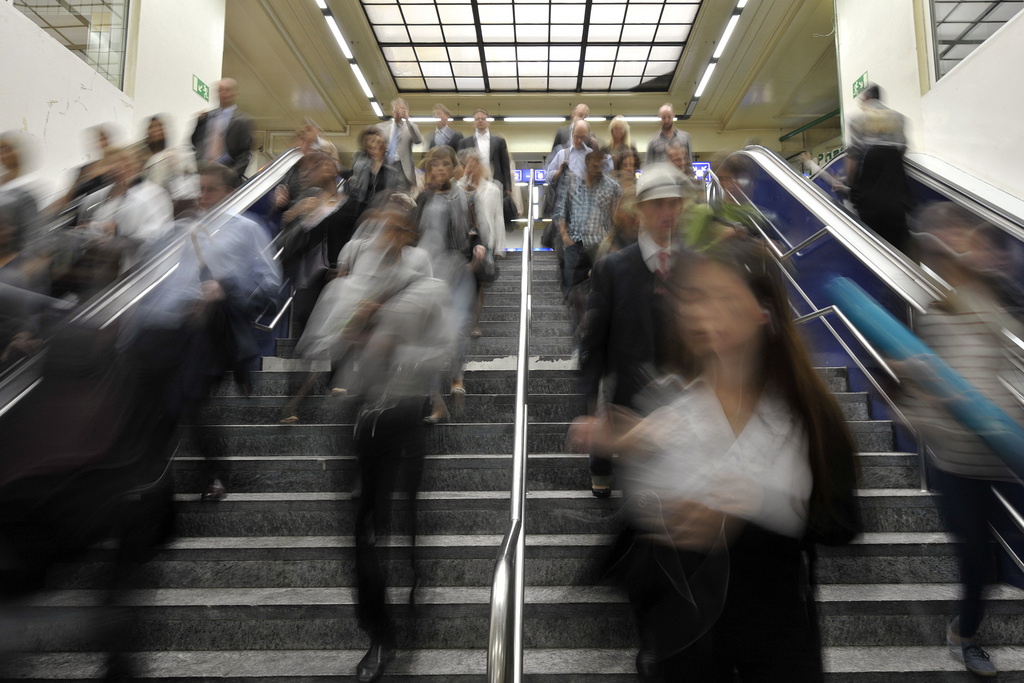Lake Geneva tunnel vote heats up

Could Geneva’s chronic traffic problems be eased by a new road tunnel under the lake? On September 28 locals will decide when they vote on plans to build a 1.5-kilometre-long tunnel close to the city’s famous Jet d’Eau fountain.
For years Geneva has been grappling with the thorny issue of whether to build a tunnel or a new bridge – or nothing at all – to help people cross from one side of the lake to the other and help congestion (see infobox below).
The issue is once again back at the ballot box. Citizens from canton Geneva can vote on a rightwing Swiss People’s Party initiativeExternal link, backed by the populist Geneva Citizens’ Movement and the Touring Club of Switzerland (TCS) motoring association, to construct a tunnel at the far western end of the lake, known locally as “La Rade”.
Supporters argue that Geneva suffers from huge mobility problems and a new road tunnel under the lake is urgently needed, especially as 100,000 new inhabitants are expected to move to the region in the next 15 years.
“The authorities have no solutions to relieve the heavily congested city centre nor to offer an alternative when the Mont Blanc Bridge has to be renovated in the near future,” bemoaned the president of the Geneva branch of the People’s Party, Céline Amaudruz.
Switzerland’s second biggest city is at a busy crossroads with France and the Alps. In addition to its 450,000 local residents, every day some 109,000 people commute to work from across the French border and from neighbouring canton Vaud.
The city centre and its main lake crossing point – the Mont Blanc Bridge – are often snarled up with traffic. Poor cantonal road infrastructure is hurting the local economy, say the Rade tunnel supporters. The TCS estimates 25,000 working hours are lost every day in Geneva owing to traffic jams.
“Outdated and too expensive”
But most other political parties as well as a number of environmental and local community groups reject the initiativeExternal link, calling it outdated, too expensive and environmentally unfriendly.
Armed with their own impact study and statistics, they say the Rade tunnel will actually make things worse, creating a pull-effect, gridlock and pollution at the tunnel access points close to the centre.
The project may also cause irreversible damage to a local park, lakeside areas and a groundwater source that provides 20% of the canton’s drinking water, they warn.
“It will undoubtedly increase the traffic problems that it claims it will resolve and lengthen traffic jams, which will be detrimental to local residents. No other city would launch such a project in its city centre,” said Geneva Mayor Sami Kanaan, a member of the centre-left Social Democratic Party.
Each side has been throwing around cost estimates varying between CHF660 million-CHF1.5 billion ($705 million-$1.6billion). Opponents argue this is far too much for the cash-strapped canton to bear alone, and would impact on current ten-year infrastructure investment plans.
To add to voters’ confusion, the centre-right Radical and Christian Democrat parties recently launched their own plans for a future cantonal initiative: a longer 4km tunnel at a wider part of the lakeExternal link, which would link up to the cantonal ring road and Swiss-French motorway network. This would cost CHF3.5 billion and may be eligible for federal funds. But the project is not likely to be realised before 2030 at the earliest – or 2050, according to critics.
While the People’s Party says the two projects are complementary, opponents say the shorter Rade tunnel would kill Bern’s potential backing for the longer one.
Sharp exchanges
In recent weeks local debate has heated up, with sharp exchanges between the two sides and irate letters from residents to local papers.
“A new lake crossing…yes and quickly! It doesn’t matter if it’s small or big, financed with public or private money, free or if it costs something. Geneva has turned into a mousetrap for anyone wanting to pass from one side of the lake to the other at any time of the day,” wrote local resident Françoise Buffat in the Tribune de Genève newspaper.
But is a tunnel or bridge really the answer to Geneva’s traffic problems? Vincent Kaufmann, an urban mobility specialist at Lausanne’s Federal Institute of Technology (EPFL), is not convinced.
“The Rade tunnel won’t resolve anything except create new traffic jams. It will also be very expensive and lead to a reduction in the use of public transport,” he commented.
“The world has changed”
The longer lake tunnel is not the solution either, added Kaufmann: “Over the past 15 years car ownership in canton Geneva has fallen from 500 per 1,000 households to around 420. If the number of people giving up their cars continues to fall, and if we have lower population growth as in the current climate, and the CEVA regional train network is finalised before 2020, I’m not sure we need these kinds of crossings.”
The real problem is the canton’s policy towards cars, and the fact that the debate in Geneva over a new bridge or tunnel has hardly shifted in the past 20 years, said the EPFL professor.
“But the world has changed,” said Kaufmann. “The problem in Geneva is that they’ve tried to improve public transport while maintaining cars across the city. But you can’t do both. At one point you need to make clear choices like Bordeaux, Strasbourg and many cities in Germany have done.”
The new initiative proposes a tunnel with two lanes in each direction under the lake linking Avenue de France on the northern bank with Port Noir, a marina on the south side.
The question of whether to build a bridge or tunnel in Geneva to help people cross from one side of the lake to the other and ease congestion has been debated for years.
In 1896 painter and architect Albert Trachsel presented a project for a tunnel at the Rade in Geneva to preserve the lakeside view. In 1943 architect Emile-Albert Favre published a study on the need for a raised bridge. Then in 1945 he revised his plans in favour of demolishing the Mont Blanc Bridge and replacing it with two tunnels.
In June 1988 68% of local voters agreed in principle to a new lake crossing. However, in June 1996 two-thirds of voters rejected plans to build either a tunnel or a bridge across the lake.

In compliance with the JTI standards
More: SWI swissinfo.ch certified by the Journalism Trust Initiative












You can find an overview of ongoing debates with our journalists here . Please join us!
If you want to start a conversation about a topic raised in this article or want to report factual errors, email us at english@swissinfo.ch.